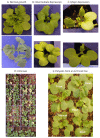A Set of Yellow Mustard (Sinapis alba L.) Germplasm with Polycotyledony
- PMID: 38068560
- PMCID: PMC10707805
- DOI: 10.3390/plants12233919
A Set of Yellow Mustard (Sinapis alba L.) Germplasm with Polycotyledony
Abstract
A world collection of 132 yellow mustard (Sinapis alba L.) accessions was characterized in a greenhouse to identify germplasm with polycotyledony and to assess the genetic segregation of tricot and tetracot seedlings in selfed S1 and S2 generations. The effort identified a set of 46 yellow mustard accessions with frequent occurrences of polycotyledony. The revealed genetic segregations seemed to suggest the development of tricot and tetracot seedlings in yellow mustard was largely controlled by a combination of genes at multiple diallelic loci. The identified tricot germplasm can be used to facilitate the genetic and/or genomic analysis of polycotyledonous germplasm for a better understanding of genetic and developmental mechanisms conditioning polycotyledony and the development of yellow mustard lines for explorable tricot breeding.
Keywords: inheritance of polycotyledony; polycotyledonous germplasm; tetracot; tricot; tricot breeding; yellow mustard.
Conflict of interest statement
The author declares no conflict of interest.
Figures

Similar articles
-
Construction of a genetic linkage map and QTL analysis of erucic acid content and glucosinolate components in yellow mustard (Sinapis alba L.).BMC Plant Biol. 2013 Sep 26;13:142. doi: 10.1186/1471-2229-13-142. BMC Plant Biol. 2013. PMID: 24066707 Free PMC article.
-
Microsatellite Markers: A Tool to Assess the Genetic Diversity of Yellow Mustard (Sinapis alba L.).Plants (Basel). 2023 Nov 29;12(23):4026. doi: 10.3390/plants12234026. Plants (Basel). 2023. PMID: 38068661 Free PMC article.
-
The complete chloroplast genome sequence of yellow mustard (Sinapis alba L.) and its phylogenetic relationship to other Brassicaceae species.Gene. 2020 Mar 20;731:144340. doi: 10.1016/j.gene.2020.144340. Epub 2020 Jan 7. Gene. 2020. PMID: 31923575
-
White Mustard (Sinapis alba L.) Oil in Biodiesel Production: A Review.Front Plant Sci. 2020 Apr 2;11:299. doi: 10.3389/fpls.2020.00299. eCollection 2020. Front Plant Sci. 2020. PMID: 32300349 Free PMC article. Review.
-
The tricot approach: an agile framework for decentralized on-farm testing supported by citizen science. A retrospective.Agron Sustain Dev. 2024;44(1):8. doi: 10.1007/s13593-023-00937-1. Epub 2024 Jan 25. Agron Sustain Dev. 2024. PMID: 38282889 Free PMC article. Review.
Cited by
-
Polycotyly: How Little Do We Know?Plants (Basel). 2024 Apr 9;13(8):1054. doi: 10.3390/plants13081054. Plants (Basel). 2024. PMID: 38674463 Free PMC article. Review.
References
-
- Guppy H.B. Science-Gossip. Simpkin Marshall, Hamilton, Kent and Co., Ltd.; London, UK: R. Friedländer & Sohn; Berlin, Germany: 1895. Irregularity of some cotyledons; pp. 171–172.
-
- Holtorp H.E. Tricotyledony. Nature. 1944;153:13–14. doi: 10.1038/153013a0. - DOI
-
- Haskell G. Seedling morphology in applied genetics and plant breeding. Bot. Rev. 1961;27:382–421. doi: 10.1007/BF02860811. - DOI
-
- Haskell G. Selection for pleiocotyly and correlated responses in inbred lines of cultivated tomatoes. Heredity. 1962;17:602.
-
- Rick C.M., Baergen K., Chmielewska W., Tarquis A.M., Chetelat R.T. Polycot (pct), a useful new seedling maker for 9S. Rep. Tomato Genet. Coop. 1992;42:31–32.
Grants and funding
LinkOut - more resources
Full Text Sources
Miscellaneous

